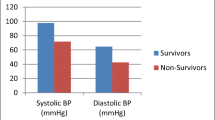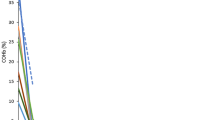Abstract
Introduction
Cardiotoxicity represents the primary cause of death in acute aluminum phosphide (AlP) poisoning. Prompt supportive care can improve patient survival. This study assessed the role of echocardiography in estimating the survival probability of AlP-poisoned patients admitted to the intensive care unit.
Methods
A prospective cohort study of symptomatic acute AlP poisoned patients was conducted between September 2019 and December 2020. Patients were subjected to history taking, clinical examination, To be included, patient evaluation needed to include electrocardiographic (ECG) and echocardiographic studies. The statistical analysis assessed the association between patient survival and relevant factors. Survival analysis was performed using the Kaplan–Meier survival curve and Cox proportional hazard regression.
Results
A total of 90 patients met inclusion criteria. Electrocardiographic abnormalities were detected in 38.1% of survivors and 82.6% of non-survivors (p < 0.001). Survivors had a higher mean left ventricle ejection fraction (LVEF) (50.86 ± 6.30% vs. 26.52 ± 7.64%, respectively, p < 0.001) and a lower percentage of global LV hypokinesia (4.8% vs. 94.2%, p < 0.001). The mean survival time was higher among patients with LVEF ≥ 50% than those with LVEF = 41–49% and ≤ 40% (p = 0.014 and 0.001, respectively). The hazard of death was 4.42 and 5.40 times greater in patients with LVEF ≤ 40% or with global LV hypokinesia, respectively. Regression revealed that the global LV hypokinesia, ECG abnormalities, and decreased LVEF and oxygen saturation were significantly associated with the risk of death (hazard ratios: 4.382, 3.348, 0.957, and 0.971, respectively).
Conclusions
Echocardiography represents a valuable diagnostic tool to assess cardiac function in acute AlP poisoning. Both LVEF and global LV hypokinesia significantly impact the survival of AlP-poisoned patients. Echocardiography was superior to ECG changes in terms of accuracy for the prediction of mortality.



Similar content being viewed by others
References
Garg KK. Review of aluminum phosphide poisoning. IInt J Med Sci Public Health. 2020;9(7):392–400.
Badawi SM, Alseidy AM, Alfeki AK, Mansour M, Abd E-H. Metal phosphide poisoning in Menoufia University Hospitals. MMJ. 2018;31(3):816.
Farahani MV, Soroosh D, Marashi SM. Thoughts on the current management of acute aluminum phosphide toxicity and proposals for therapy: an evidence-based review. Indian J Crit Care Med. 2016;20(12):724–30. https://doi.org/10.4103/0972-5229.195712.
Hashemi-Domeneh B, Zamani N, Hassanian-Moghaddam H, Rahimi M, Shadnia S, Erfantalab P, Ostadi A. A review of aluminium phosphide poisoning and a flowchart to treat it. Arh Hig Rada Toksikol. 2016;67(3):183–93. https://doi.org/10.1515/aiht-2016-67-2784.
Bumbrah GS, Krishan K, Kanchan T, Sharma M, Sodhi GS. Phosphide poisoning: a review of literature. Forensic Sci Int. 2012;214(1):1–6. https://doi.org/10.1016/j.forsciint.2011.06.018.
Halvaei Z, Tehrani H, Soltaninejad K, Abdollahi M, Shadnia S. Vitamin E as a novel therapy in the treatment of acute aluminum phosphide poisoning. Turk J Med Sci. 2017;47(3):795–800. https://doi.org/10.3906/sag-1512-6.
Asghari MH, Abdollahi M, de Oliveira MR, Nabavi SM. A review of the protective role of melatonin during phosphine-induced cardiotoxicity: focus on mitochondrial dysfunction, oxidative stress and apoptosis. J Pharm Pharmacol. 2017;69(3):236–43. https://doi.org/10.1111/jphp.12682.
Sciuto AM, Wong BJ, Martens ME, Hoard-Fruchey H, Perkins MW. Phosphine toxicity: a story of disrupted mitochondrial metabolism. Ann N Y Acad Sci. 2016;1374(1):41–51. https://doi.org/10.1111/nyas.13081.
Baruah U, Sahni A, Sachdeva HC. Successful management of aluminium phosphide poisoning using intravenous lipid emulsion: report of two cases. Indian J Crit Care Med. 2015;19(12):735–8. https://doi.org/10.4103/0972-5229.171412.
Mehrpour O, Gurjar M. Cardiogenic shock: the main cause of mortality in acute aluminum phosphide poisoning. Indian J Crit Care Med. 2017;21(4):246–7. https://doi.org/10.4103/ijccm.IJCCM_97_17.
Hassanian-Moghaddam H, Amiri H, Zamani N, Rahimi M, Shadnia S, Taherkhani M. QT dispersion and prognostication of the outcome in acute cardiotoxicities: a comparison with SAPS II and APACHE II scoring systems. Cardiovasc Toxicol. 2014;14(2):129–33. https://doi.org/10.1007/s12012-013-9236-9.
Kim YH, Lee JH, Hong CK, Cho KW, Park YH, Kim YW, Hwang SY. Heart rate-corrected QT interval predicts mortality in glyphosate-surfactant herbicide-poisoned patients. Am J Emerg Med. 2014;32(3):203–7. https://doi.org/10.1016/j.ajem.2013.09.025.
Lionte C, Sorodoc V, Bologa C, Tuchilus C, Jaba E. Usefulness of transthoracic echocardiography parameters and brain natriuretic peptide as mortality predictors in hospitalized acutely poisoned patients: a prospective observational study. Basic Clin Pharmacol Toxicol. 2017;120(5):498–504. https://doi.org/10.1111/bcpt.12711.
Soltaninejad K, Beyranvand MR, Momenzadeh SA, Shadnia S. Electrocardiographic findings and cardiac manifestations in acute aluminum phosphide poisoning. J Forensic Leg Med. 2012;19(5):291–3. https://doi.org/10.1016/j.jflm.2012.02.005.
Kalawat S, Thakur V, Thakur A, Punjabi N. Cardiovascular profile of aluminium phosphide poisoning and its clinical significance. Int Adv Med. 2016;3(4):859–64.
Hilal MA, Mahmoud SE, Shokry MM, Said AM. Predictive role of cardiac troponin I, creatine kinase-Mb and electrocardiogram in early assessment of acute cardiotoxicity in patients poisoned by cardiotoxic drugs and toxins. Cardiol Angiol: Int J. 2020:18–30. https://doi.org/10.9734/ca/2020/v9i330136.
Sheta AA, El-Banna AS, Elmeguid RA, Mohamed HE, Gad NH. A study of the predictive factors of mortality in acute poisoning with aluminum phosphide with special reference to echocardiography and SOFA score. Environ Sci Pollut Res Int. 2019;26(32):33135–45. https://doi.org/10.1007/s11356-019-06457-4.
Abdel-Hady RH, Mohamed AA, Mohammed MK. Supportive measures in the treatment of aluminum phosphide poisoning as a trial to reduce mortality at Assiut university hospital. Egypt AJFSFM. 2019;1:1210–22.
Akkaoui M, Achour S, Abidi K, Himdi B, Madani A, Zeggwagh AA, Abouqal R. Reversible myocardial injury associated with aluminum phosphide poisoning. Clin Toxicol (Phila). 2007;45(6):728–31. https://doi.org/10.1080/15563650701517350.
Oghabian Z, Mehrpour O. Treatment of aluminium phosphide poisoning with a combination of intravenous glucagon, digoxin and antioxidant agents. Sultan Qaboos Univ Med J. 2016;16(3):e352-e5; https://doi.org/10.18295/squmj.2016.16.03.015
Changal KH, Latief M, Parry M, Abbas F. Aluminium phosphide poisoning with severe cardiac dysfunction and the role of digoxin. BMJ Case Rep. 2017;2017:bcr2017220125; https://doi.org/10.1136/bcr-2017-220125
Elabbassi W, Chowdhury MA, Fachtartz AA. Severe reversible myocardial injury associated with aluminium phosphide toxicity: a case report and review of literature. J Saudi Heart Assoc. 2014;26(4):216–21. https://doi.org/10.1016/j.jsha.2013.11.006.
Mehrpour O, Asadi S, Yaghoubi MA, Azdaki N, Mahmoodabadi N, Javadmoosavi S. Cardiogenic shock due to aluminum phosphide poisoning treated with intra-aortic balloon pump: a report of two cases. Cardiovasc Toxicol. 2019;19(5):474–81. https://doi.org/10.1007/s12012-019-09513-0.
Chugh SN, Ram S, Chugh K, Malhotra KC. Spot diagnosis of aluminium phosphide ingestion: an application of a simple test. J Assoc Physicians India. 1989;37(3):219–20.
McDonagh TA, Metra M, Adamo M, Gardner RS, Baumbach A, Böhm M, Burri H, Butler J, Čelutkienė J, Chioncel O, Cleland JGF, Coats AJS, Crespo-Leiro MG, Farmakis D, Gilard M, Heymans S, Hoes AW, Jaarsma T, Jankowska EA, Lainscak M, Lam CSP, Lyon AR, McMurray JJV, Mebazaa A, Mindham R, Muneretto C, Francesco Piepoli M, Price S, Rosano GMC, Ruschitzka F, Kathrine Skibelund A, Group ESCSD. 2021 ESC Guidelines for the diagnosis and treatment of acute and chronic heart failure: developed by the Task Force for the diagnosis and treatment of acute and chronic heart failure of the European Society of Cardiology (ESC) With the special contribution of the Heart Failure Association (HFA) of the ESC. Eur Heart J. 2021;42(36):3599–726; https://doi.org/10.1093/eurheartj/ehab368
Moghadamnia AA, Abdollahi M. An epidemiological study of poisoning in northern Islamic Republic of Iran. East Mediterr Health J. 2002;8(1):88–94.
Proudfoot AT. Aluminium and zinc phosphide poisoning. Clin Toxicol (Phila). 2009;47(2):89–100. https://doi.org/10.1080/15563650802520675.
Louriz M, Dendane T, Abidi K, Madani N, Abouqal R, Zeggwagh AA. Prognostic factors of acute aluminum phosphide poisoning. Indian J Med Sci. 2009;63(6):227–34. https://doi.org/10.4103/0019-5359.53386.
El-Sarnagawy G. Predictive factors of mortality in acute aluminum phosphide poisoning: 5 years retrospective study in Tanta Poison Control Unit. Ain Shams J Forensic Med Clin Toxicol. 2017;29(2):70–9.
Erfantalab P, Soltaninejad K, Shadnia S, Zamani N, Hassanian-Moghaddam H, Mahdavinejad A, Damaneh BH. Trend of blood lactate level in acute aluminum phosphide poisoning. World J Emerg Med. 2017;8(2):116–20. https://doi.org/10.5847/wjem.j.1920-8642.2017.02.006.
Hosseini SF, Forouzesh M, Maleknia M, Valiyari S, Maniati M, Samimi A. The molecular mechanism of aluminum phosphide poisoning in cardiovascular disease: pathophysiology and diagnostic approach. Cardiovasc Toxicol. 2020;20(5):454–61. https://doi.org/10.1007/s12012-020-09592-4.
Solgi R, Baghaei A, Golaghaei A, Hasani S, Baeeri M, Navaei M, Ostad SN, Hosseini R, Abdollahi M. Electrophysiological and molecular mechanisms of protection by iron sucrose against phosphine-induced cardiotoxicity: a time course study. Toxicol Mech Methods. 2015;25(4):249–57; https://doi.org/10.3109/15376516.2015.1015086
Chugh SN, Chugh K, Ram S, Malhotra KC. Electrocardiographic abnormalities in aluminium phosphide poisoning with special reference to its incidence, pathogenesis, mortality and histopathology. J Indian Med Assoc. 1991;89(2):32–5.
Zniber K. Reversible myocardial injury associated with aluminum phosphide poisoning: case report. Sch J Med Case Rep. 2021;5:476–9.
Shadnia S, Sasanian G, Allami P, Hosseini A, Ranjbar A, Amini-Shirazi N, Abdollahi M. A retrospective 7-years study of aluminum phosphide poisoning in Tehran: opportunities for prevention. Hum Exp Toxicol. 2009;28(4):209–13. https://doi.org/10.1177/0960327108097194.
Agrawal VK, Bansal A, Singh RK, Kumawat BL, Mahajan P. Aluminum phosphide poisoning: possible role of supportive measures in the absence of specific antidote. Indian J Crit Care Med. 2015;19(2):109–12. https://doi.org/10.4103/0972-5229.151019.
El Hangouche AJ, Fennich H, Alaika O, Dakka T, Raissouni Z, Oukerraj L, Doghmi N, Cherti M. Reversible myocardial injury and intraventricular thrombus associated with aluminium phosphide poisoning. Case Rep Cardiol. 2017;2017:6287015; https://doi.org/10.1155/2017/6287015
Klaeboe LG, Edvardsen T. Echocardiographic assessment of left ventricular systolic function. J Echocardiogr. 2019;17(1):10–6. https://doi.org/10.1007/s12574-018-0405-5.
Park JS, Seo KW, Choi BJ, Choi SY, Yoon MH, Hwang GS, Tahk SJ, Choi SC, Min YG, Shin JH. Various echocardiographic patterns of left ventricular systolic dysfunction induced by carbon monoxide intoxication. Cardiovasc Toxicol. 2016;16(4):361–9. https://doi.org/10.1007/s12012-015-9347-6.
Ozyurt A, Karpuz D, Yucel A, Tosun MD, Kibar AE, Hallioglu O. Effects of acute carbon monoxide poisoning on ECG and echocardiographic parameters in children. Cardiovasc Toxicol. 2017;17(3):326–34. https://doi.org/10.1007/s12012-016-9389-4.
Lionte C, Bologa C, Petris O, Sorodoc V, Stoica A, Tuchilus C, Jaba E, Coman AE, Vata L, Haliga R. Parameters influencing in-hospital mortality in acutely poisoned patients hospitalized in a medical or ICU ward: is there an influence of toxin-induced myocardial injury? Romanian Journal of Cardiology. 2019;29(3):404–10.
Bansal M, Ranjan S. Echocardiography in the management of cardiogenic shock. Indian J clinical Cardiology. 2020;1(1):20–30.
Boyd JH, Sirounis D, Maizel J, Slama M. Echocardiography as a guide for fluid management. Crit Care. 2016;20(1):274. https://doi.org/10.1186/s13054-016-1407-1.
Mohammadi AB, Nahandi AZ, Solhi H. Utility of silver nitrate test for post-mortem diagnosis of aluminum phosphide poisoning. Iran J Toxicol. 2013;7(20):804–7.
Funding
None
Author information
Authors and Affiliations
Contributions
FME and ASAFH conceived the study, contributed to the idea and the design of the research, and drafted the manuscript. FME also performed the statistical analysis of the data as well as edited and revised the manuscript in its final form. MAS shared the study design, collection of the data, AND interpretation of the results. OMS was responsible for performing and interpreting the echocardiography findings. All authors contributed substantially to the revision of the final manuscript.
Corresponding author
Ethics declarations
Conflict of Interest
The authors declare no competing interests.
Additional information
Supervising Editor: David Michael Wood, MD
Publisher's Note
Springer Nature remains neutral with regard to jurisdictional claims in published maps and institutional affiliations.
Rights and permissions
About this article
Cite this article
Elgazzar, F.M., Shama, M.A., Shoeib, O. et al. The Role of Echocardiographic Findings in Estimating Survival Probability of Intensive Care Unit Admitted Aluminum Phosphide Poisoned Patients. J. Med. Toxicol. 18, 128–138 (2022). https://doi.org/10.1007/s13181-021-00868-x
Received:
Revised:
Accepted:
Published:
Issue Date:
DOI: https://doi.org/10.1007/s13181-021-00868-x




